#ttte headcanons
Text
[Jameward Headcanon] I can pinpoint the exact moment these two fell in love
In my opinion, I would definitely say that this was a case of "fell first" vs "fell harder" (though both of them absolutely adore each other)
Let's start with Edward first, shall we?
Edward always thought James was attractive. Something about that engine's confidence just naturally drew Edward to him.
But that day Edward saw James in his red paint for the first time...
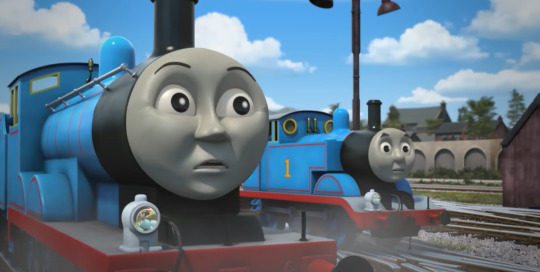
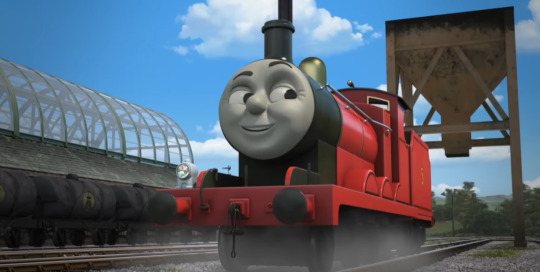

It was like something clicked. Like Edward KNEW, "This guy, this one right here. This one's the love of my life."
Seriously, watch that scene again and look at Edward's expressions! The way his jaw DROPPED, followed by the wide eyes and big smile. Old Iron was SWOONING. He's got HEART EYES.
But of course, Edward didn't want to say anything right away. He knew that HE was in love, but he didn't think James would feel the same way. Surely, someone like James would want an engine who was younger or bigger or stronger than he was. So Edward continued to love him silently, and supported James through his first days as he would have any other friend.

Now on James's end, he always appreciated Edward being there for him. I like to think he was probably more comfortable around Edward than any other engine at this time. Even in later years, I think James still finds Edward the most comfortable to be around, but we'll get to that another time.
The point is, James and Edward were pretty close, but James still didn't think of Edward as anyone other than "Old, Reliable Edward" yet. He was a close friend, and like any other friend, sometimes James gets annoyed with him.
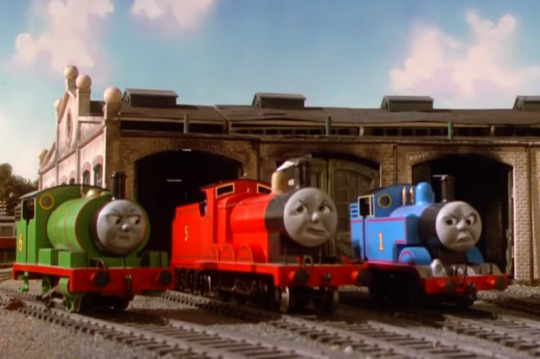
"Edward is impossible! He clanks about like a lot of old iron! And he's so slow, he makes us wait!"
Little did James know he would be eating those words later that day.
Fast forward some time. James has become a runaway again. He has no driver. He's all alone and he's terrified. And who comes speeding down the line to come save him?
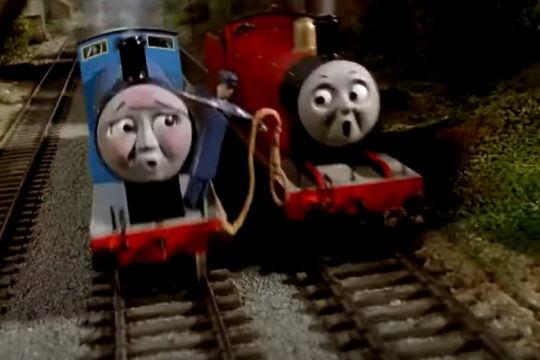
Why, it's Edward of course!
And as they're puffing along the line together, side by side, James realizes things all at once. It's not just that Edward is the most comfortable to be around, he feels safe with him! Secure with him! Edward's got him!
Before he even thinks about it, he just says how he feels in that moment.
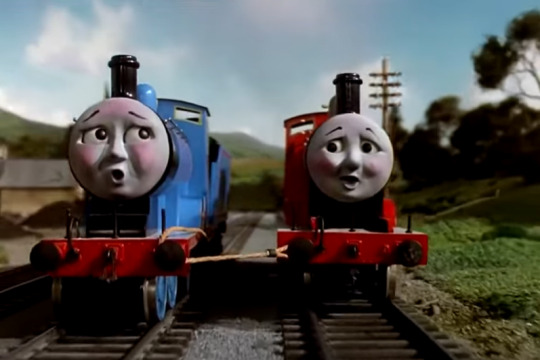
"You were splendid Edward."
Splendid. That's a word James usually reserves for himself. But Edward can have it today. And tomorrow if he wanted. Edward deserved it.
Oh, and let's not leave this part out from the books.
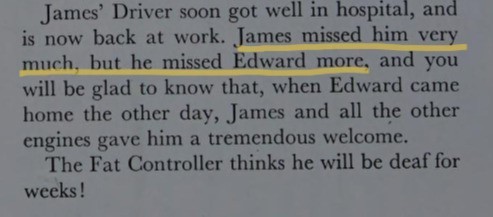
James missed Edward more than his own driver!
I don't know about you fellas, but that sounds gay to me.
From "Old Iron" onwards, James knew he was in love with Edward. But that didn't mean he said anything about it. In fact, he was pretty in denial about it for some time. But by the time we reach "James the Second Best", I think that's when James finally accepts that he has feelings for Edward. And once we get to "All in Vain", James and Edward have already started dating.
Or alternatively, they've both reached a point where they both just acknowledge that their feelings for each other are mutual. Sometimes I like to think that steam engine courtship is less formalized than it is for us humans. A simple "we both love each other", and then being extra sweet whenever they happen to be in the same vicinity. It's hard to go on dates when you've got jobs to do everyday.
But the point is, by the time we reach the events of "All in Vain", James and Edward are basically already together. And everyone knows it. 💙❤

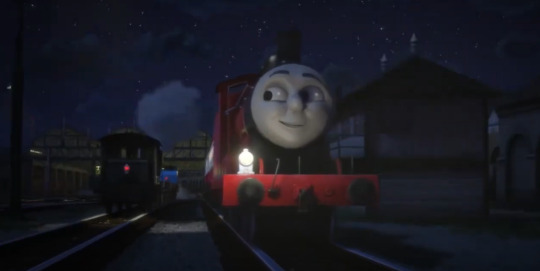
#ttte#thomas and friends#jameward#ttte 2x5#2x5#ttte james#ttte edward#ttte headcanons#i just have A LOT of feelings about them okay#they are the train gays ever#redengineposts#randys headcanons#james the red engine#edward the blue engine
105 notes
·
View notes
Text
no longer episoding, have edward
Shes here
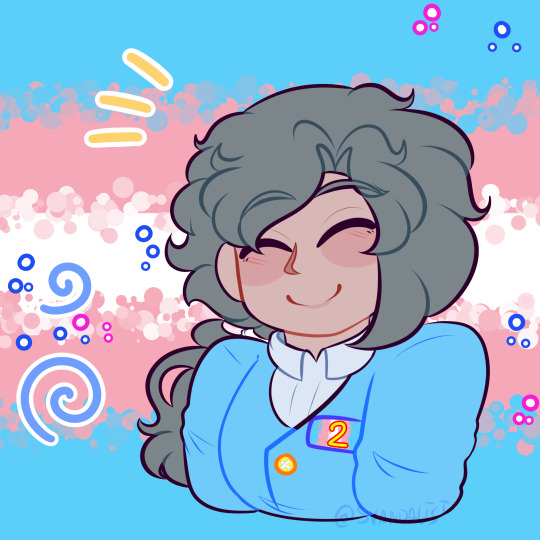
#ttte#thomas and friends#thomas the tank engine#ttte ask blog#ttte gone dutch#ttte au#ttte humanized#ttte human au#ttte headcanons#ttte edward#edward the blue engine#ttte edward the blue engine#ttte transfem edward#ttte humanization#ttte humans#ttte human#ttte gijinka#ttte aus#ttte gone dutch au#gone dutch au
116 notes
·
View notes
Note
Holding out my hands for any Charlie Sand HCs you got !! You draw him sooo silly.

The silly men!! you get the bonus of having a few hcs for the stoker as well ;)
Charlie Sands:
“Never you mind about Johnny!” laughed the driver, “Just you climb on the cab and look for Thomas!”
- One of the NWR’s longest working railwaymen, has been around since it’s beginnings. Chill and stern, kinda under reacts sometimes but it’s cool. Level headed and can crack jokes in a lot of situations, a quick thinker and adept at adapting to odd situations.
- Lived on Sodor for all his life, very well versed into it’s ins and outs and is usually seen as one of the mentors for new workers.
- Before becoming Edward’s Driver he was Lady’s fireman before graduating to the driver position to help Edward adjust to being on Sodor with the power of his chill attitude. Charlie has been a crew member on other engines though!
Sidney Holloman (Hever):
“Oh dear what can the matter be?” singed the fireman.
- Comparatively a little more new to the Railway, Edward went through one other fireman before Sidney dropped in. Sharp and snarky, doesn’t sugarcoat his words and blunt mouthed, has a bit of an eye for mechanics.
- Used to live in Barrow-in-Furness before moving to Sodor by stowing away on a cargo boat that was heading to Sodor, first worked as Thomas’ fireman before being moved to become Edward’s. Has a bit of a criminal background but he tries to hide that.
- Passionate singer, wanted to be a musician when he was younger.
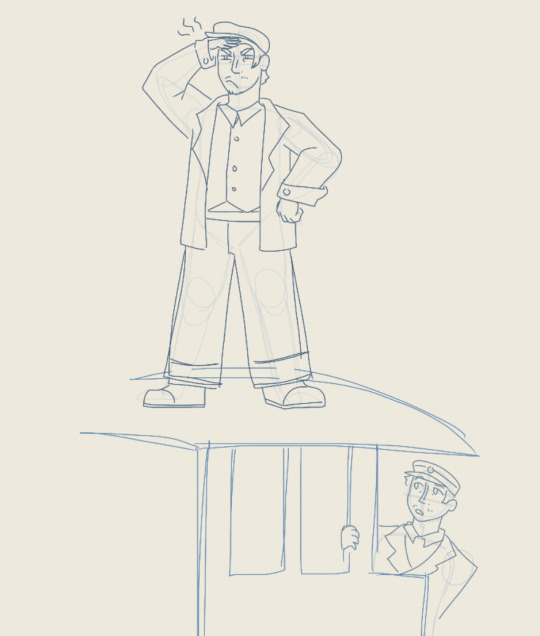
#daryl draws#answer#ttte#thomas the tank engine#ttte headcanons#ttte drivers#ttte charlie sand#ttte sidney hever#and ty!! charlie sands can look silly as a treat
33 notes
·
View notes
Text
The Concept of Family in British locomotives
Let's talk about the family concept in British locomotives. This concept has changed through the history of railways in Britain, so we will be primarily focusing on the North Western Railway's Flagship Express Locomotive, No.4 Gordon, once we reach the 20th century.
In the early days of steam, all Locomotives were cousins, as there were so few, but as their numbers grew, locomotives began to associate locomotives sharing the same builder as kin, and the concept of all locomotives being related would slowly fade. The concept of classes of steam locomotives was at best primitive at the time, as technology progressed with such speed that oftentimes an engine was outdated before construction was completed. All engines of the same builder were seen as cousins or ancestors. Siblings were a rare concept at the time, reserved for unusually close engine pairs
As the form and technology of the steam locomotives settled into established forms, classes began to appear with greater frequency. Batches of engines began to appear built to the same design. Built alongside each other, these engines quickly were recognized as siblings and often had close relationships. Complimenting the existing cousins of the same builders.
By this time Railways were growing (and absorbing each other) rapidly. The idea of all engines of a railway being family fell to the wayside quietly on the larger lines, with fleetmates instead being seen as team members.
It was into the end of this era that Great Northern Railway No.100 was first steamed. One of the first Pacifics to be built in the British Isles (and the first successful standard gauge one). No.100 Gordon was the testbed for Sir Nigel Gresley's next-generation express locomotive. As an experimental express testbed, he represented the vision and hope for the future of the railway and was held in high esteem by the other engines on the railway. His high-performance levels only increased his status. However, this status came with the fact. While amicable with the existing express 4-4-2s and 4-6-0s, they were hardly family. While Gresley had designed other locomotives, they were either shunters, freight engines, or smaller mixed traffic designs, and as such rarely crossed paths with their younger cousin. This would change in 1922 with the introduction of No.1470, Great Northern.
Great Northern was the result of Gordon's testing, the first production pacific on the GNR (or Britain). Finally, Gordon had a sibling. Gordon was quickly found to be protective of his little brother, determined that they would never know the loneliness he felt. They were soon joined by No.1471 Sir Fredrick Branbury before the event that shook their world. Grouping arrived with the dawn of 1923.
Grouping saw the railways of the British mainland organized into 4 new railways. The London Midland and Scotland Railway, the Great Western Railway, the Southern Railway, and the A1s new home: The London North Eastern Railway. Seemingly overnight the idea of the railway being your family would be struck down for the majority of lines in Britain, as those railways suddenly no longer existed. Each of the "big four" fleets responded differently. The LMS largely let the concept lie, indifferent to how their locomotives saw each other as long as they performed to expectations.
The Great Western aggressively pushed the concept of The Great Western Way, and the idea they were all "Great Western." Decades later in the 1980s, the surviving pre-grouping locos would adopt a TV line to describe the experience with the phrase, "Resistance is futile, you will be Swindonized."
The Southern came together as a team out of sheer necessity to keep the railway running, but the pre-grouping locomotives would never quite see each other (or the Southern-built engines) as family. Teammates for certain, but the majority still identified themselves by their pre-grouping line.
The LNER closed ranks under the leadership of their express engines. The A1s, including the newly built 1472. found themselves suddenly sharing sheds alongside the Raven-designed Rival A2 pacifics, City of Newcastle and City of Kingston upon Hull. Many expected the two classes to clash, but when No.2400 and 2401 pulled into the sheds, No.100 saw the same weight and loneliness he had borne before his sibling's construction. Before any of the others in the shed could speak Gordon firmly welcomed the former NER engines as cousins. This precedent would be followed by the other express classes, eventually spreading throughout the LNER. In the end, the Gresley A1 would be chosen as the LNER's flagship express engine, but 8 more A2s were built, 2402-2409. No.2402-2404 had begun construction prior to grouping, but 2405-2409 were authorized by Gresley himself. Why he did this is uncertain, but it noted that No.100 had visited Doncaster for unscheduled maintenance the day before the decision was made.
However, No.100 was not destined to remain with the newly formed LNER. By August of 1923 the 10th A1, No. 1480 Enterprise had been completed at Doncaster Works. The LNER board decided that No.100 was no longer needed, preferring to replace the non-standard prototype with a production A1. Gresley argued it would be cheaper to bring No.100 in line with the production A1s, but the board wished for Great Northern to be seen as the first A1, no prototypes required, and No. 100's existence interfered with that.
Fortunately, Gresley convinced the board to sell Gordon to a Railway that desperately needed him. LNER No.100 left Doncaster and his eleven siblings in August 1923, bound for the North Western Railway.
The North Western Railway had been formed in 1915 from the existing standard gauge railways on the Island of Sodor off the coast of Barrow in Furness. The mainline had connected the western coast of Sodor to the British mainland by rail to facilitate the movement of troops and supplies during the Great War. Following the war, the island had seen a massive industrial boom with rising population levels to match. The railway's fleet was primarily composed of pre-1900 castoffs and former Railway Operating Division locomotives. None of which were suitable for the Express service between the western terminus of Tidmouth and Barrow in Furness. One may be excused for wondering why the problems of a western island railway would bear any attention from the London North Eastern Railway. The answer, as is so often true in railway politics, is spite.
In 1923 the North Western Railway had, through a combination of politics, bribes, and actions of questionable legality, managed to remain independent, much to the ire of the London Midland and Scotland Railway. The LMS, already the LNER's sworn rival, had made it their mission to absorb the NWR by any means necessary, as they felt cheated by the line's exclusion from the Grouping Act of 1923.
The LNER saw an opportunity to screw over the LMS with the sale of No.100 to the NWR. With the acquisition of the Gresley Pacific, the North Western could then manage a competitive timetable with its express without doubleheading. Gordon was checked over at Doncaster Works, painted in an express variation of North Western Passenger Blue, and sent off to the NWR with a line of older express coaches that had also been purchased.
Gresley himself turned Gordon over to the NWR, but not before telling the newly renumbered number 4 to make him proud.
The former No.100's early days on the NWR were a success from a performance standpoint, but not a social one. This point in the NWR's mainline fleet, as with many sheds following grouping, was perhaps most comparable to a pack of feral hounds fighting over a bone. Half the fleet were engines purchased during the war, older designs desperate to prove their worth to avoid the fate of their siblings on the mainland. The other half were newer, stronger, engines loaned on trial just before grouping, which saw themselves as inherently better than the rest. They believed the NWR should purchase them before they were returned to the LMS the following year and scrap the older engines. Each engine was fighting to prove themselves, especially at the cost of their competitors.
Throwing a top-of-the-line LNER Pacific into the mix only inflamed tensions. The wartime engines saw him as their worst fears confirmed, the railway purchasing new engines to replace them. The loaned engines loathed him not only for actually being everything they saw themselves as, but also for being LNER, suggesting the North Western may turn to the LNER for new motive power rather than the LMS. Gordon, stripped of his home and his siblings, was in no mood to manage either group's fears or egos.
It is impossible to guess how much longer this state of affairs may have went on for had it not been for the NWR's No.3. No.3 "Henry" was the North Western's previous attempt at purchasing a suitable express locomotive. A 4-6-2 built from stolen Gresley plans, Henry had been a poor steamer, and had struggled with the lesser Expresses, and was utterly incapable of pulling the flagship Wil'Nor'Wester. It had all come to a head two weeks after Gordon had arrived when the pacific had stopped in a tunnel during a storm and refused to come out, resulting in the Railway's general manager, the future Sir Topham Hatt, lifting the rails and bricking the tunnel entrance. Gordon, used to Gresley's high standards for express engines, initially held little sympathy for the confined engine, and even less hesitation in letting said engine know his opinion as he shot past. However as time passed, and Gordon's loneliness grew, he could help but see his siblings in No.3's place. Finally, in late 1923, Gordon took charge of the mainline fleet. He had developed a working (if reluctant) respect for the oldest engine in the shed, a 4-4-0 of Furness origins, and together the two created a plan to save the imprisoned locomotive. One night in late autumn, the first of many "indignation meetings" on the NWR was held as Gordon faced the other engines and told them in no uncertain terms that they would be saving their fleetmate.
The plan went flawlessly. Gordon "failed" outside the tunnel and Henry was pulled out to save the train. While it was revealed that STH had known about the plan, it was still considered a success by Gordon and the majority mainline fleet. However, there was a side effect Gordon hadn't seen coming.
Gordon had expected for the engines to execute the plan, then return to fighting each other. Instead, they unified behind the flagship pacific. Whilst several engines (mostly the newer loaners) would try to challenge him for leadership, they quickly found there was no competing with the Gresley. In performance, he was both the fastest and strongest engine on the railway, as the railway's flagship engine he held the favor of the board and STH, and his willingness to damage his own performance to save another engine had earned him the fleet's loyalty.
Slowly, reluctantly, the No.4 came to see the North Western fleet as family. First came No.3, Gresley in design if not name (or performance) he was the closest Gordon had to a sibling. The old 4-4-0 (No.2 Edward) would earn the Pacific's grudging respect by his work ethic. The following year an experimental mogul from the LMS would arrive (No.5 James) which would quickly become the annoying sibling No.4 never wanted. Throughout all of this, Gordon would occasionally encounter his siblings. It became a tradition for any new LNER express locomotive to make the run to meet Gordon on the NWR, so he would eventually meet all 79 of his siblings, and many of his cousins.
From 1925 to 1939, Gordon led the NWR in his battle for survival and independence in the world of the big four, but by 1939 his conjugated valve gear was worn and fouling. Many expected Gordon to be sent to Doncaster to be rebuilt to A3 standards like many of his siblings. Instead, STH called in a favor with the LMS's chief mechanical engineer, William Stanier. Gordon arrived in Crewe Works stoic and dignified, expecting to be treated as the enemy by the LMS Pacifics and 4-6-0s. Instead. He received a hero's welcome.
While the two companies were rivals, Gresley and Stanier knew each other, and CMEs were often known to discreetly share ideas and progress. Gordon was Britain's first (successful) pacific, and the Princess Royals and the new Princess Coronations saw him as their predecessor. Furthermore, No.3 had been previously rebuilt at Crewe into Black 5 4-6-0 following a 1935 accident, so as Henry's adopted sibling, he was considered their cousin at least. His Gresley origins could be easily ignored, he'd be a Stanier engine soon enough. For the first time, Gordon was exposed to the idea that not just LNER Pacifics, but all British Pacifics, were his family.
Then war broke out. Gordon had been scheduled for testing on the LMS following his overhaul, but instead his overhaul, but instead the Crewe workmen worked day and night to expedite his return to Sodor. On his final night on LMS metals, Gordon embraced his position as the eldest pacific in Britain for the first time. He spoke to a gathering of the premier express locomotives of the big four at London's King's Cross Station. They were no longer four railways, rivaling each other, he said, but one country standing against a common foe. Gordon departed King's Cross in the dead of night, pulling a long line of coaches filled with evacuating children.
The war on the North Western saw Gordon switch over fully to goods work for the first time in his life. With travel discouraged except in emergency, the express could be handled by smaller engines, leaving the power of the newly rebuilt express engine free for war traffic.
The binds between the NWR fleet were reforged again in steel as the railways of Britain pulled together for the war. Sodor possessed multiple ports, and these were desperately needed safe havens in the uboat-infested waters of the Atlantic. Through it all Gordon led the North Western with a firm hand, pushing all to work their hardest, but keeping overzealous engines and men from pushing his fleet mates too far. Sodor fared better than the mainland, but even this western island was not exempt from the horrors of the blitz. An image of Gordon pulling a line of flatbeds lined with tanks and artillery through Tidmouth the morning after the Blitz strike which decimated the city would become famous as a sign of both Sudrian and British resolve.
The end of the war saw Gordon return to passenger service, returning troops from the mainland to Sodor. The morning he finally returned to head the Wil'Nor Western, freshly repainted in NWR Express Passenger blue, was greeted with cheers and fanfare along the line. The war was over, but its effects were not.
On January 1st, 1948, the standard gauge railways of Britain were nationalized. The big four no longer existed, instead, there was one giant railway with four major regions...in theory. In reality, it was far more difficult to join four rival railways together than signing legislation. It was one thing for the railways to put aside their differences for the good of their country, that was quite simply an engine's duty. It was another to tell the engines and their crews that their rivals of nearly three decades were now their fleet mates. The early days of British Rails were strange indeed. While many had gained a professional respect for their peers during the war, for many engines, their railway was as integral to their identity (and the identity of other locomotives) as being British was to their crews. This was exasperated by the fact that many sheds were led by their express engines, who were built and run in direct and often intense competition with their rivals. The arrival of new locomotives which had only served under British Railways further complicated the already complex situation.
It was into this situation that Gordon would return to the Mainland in 1949. As the unofficial fifth region, the North Western had largely been ignored by British Railways, as there were enough problems managing the former big four without creating the headaches dealing with the Sudrians always invoked. Nonetheless, the North Western Region was invited to send a locomotive for the 1949 Exchange Trials. The trials were meant to directly compare the mainline locomotives in service with the newly nationalized Railway, which did absolutely nothing to dissipate the former rivalries. Gordon was the first and only, choice to represent the North Western Region. Gordon thrived in the trials. His rebuild may have lowered his top speed, but his greater power allowed him to accelerate his trains faster, even up hills. He would routinely match or exceed his Big Four peers in timings. During this time he ran expresses and fast freights alongside many of his cousins and siblings from the LNER, as well as his adopted LMS relatives. He would also develop a rivalry with the Great Western 4-6-0s at this time, as they were the only ones who could challenge him on the hills. British Railways were impressed with his performance, and many of his design elements would be translated into the future Standard 7 class Britannia. It was during this time that he would meet No.34090, Sir Eustace Missenden. She was a Battle of Britain class Light Pacific of Southern Design. Newly built, the young pacific struggled with passenger work. Young and excitable, she worked well with trucks but was deemed too flighty for express work. No one but No.4 himself knows exactly what about her caught his attention, but perhaps she reminded him of his younger siblings. In any case, the first pacific took the youngest under his wing, requesting the management arrange for them to double-head several expresses.
The southern region's management was far from stupid, and eagerly arranged for the two to work together so that she could be mentored by him. Gordon was a stern but knowledgeable teacher, and 34090 was eager to learn. By the time No.4 left for the next set of trials, 34090 was considered one of her shed's best Express engines, and although it would be years before he admitted it, Gordon had a new youngest sibling, Rebecca.
Gordon would return to the Island of Sodor after the trials, and with him came the attention of British Railways. The two organizations began circling each other, but that mattered little to Gordon, his job remained the same. With the exception of an incident in 51, Gordon's existence would remain the same as always, hauling the express and occasional freights. That would all change in 1955.
The Modernization Plan of 1955. The plan to scrap all steam locomotives on British Railways in favor of diesel locomotives. Up to this point, the North Western Region and British Rails had been trying to play nice with each other. British Railways was established with the sole purpose of bringing all standard gauge lines in Britain under one ruling body. Sodor had a history of nodding their heads whenever 'foreigners' gave them orders, then ignoring said orders. Relations between BR and their fifth region had always been strained at best. The announcement of the Modernization Plan brought on a full-on cold war. Sodor was a safe haven for steam and would remain so, even if they had to cut ties with the mainland to do it.
The North Western Region was in a fight for its very existence, and Gordon was at the head. As their Flagship express engine, Gordon was the image of the North Western to many. Every time British Rails sent a diesel for the NWR to test, Gordon would shatter their timings, proving the NWR could not only keep up with BR while using steam but beat them. As the Hatts took the political fight to London, Gordon joined a very different fight.
Sodor had long been a place where engines could escape scrap, but now there were far, far more in need. Gordon's strength and power were needed more than ever. In most cases, the mighty pacific would never see the engines snuck into the rear of his Night Express, but he always felt their weight. When the last day of steam came in BR, Gordon had never once been late with the midnight express to Tidmouth in the thirteen years since the modernization plan was announced. Even when he did see his charges, it mattered not where they came from, they were all steam engines, and they were all under threat. Even when Gordon received work of the final A3s scrapping, leaving only Flying Scotsman and himself of a class once 80 strong, he did not falter. In the latter years of steam, he faced a challenge of another type, diesels, the very engines his kind were being scrapped for, began seeking refuge. British Rails wasn't satisfied with many of its early diesels, and sent them to die with the steam engines BR had once promised they'd replaced. In 1966, Gordon found BR 10000 and 10001 hiding in the barrow yard while he went to fetch his coaches (the shunter had derailed to distract officials so Gordon could collect the engines) He stared for a long moment, the sisters nervously staring at the former LNER pacific before he sighed deeply, coupling up and shunting them to the end of his train.
Engines will often say the Lady rewards those who work hard, and few worked harder than North Western No.4. Gordon was not left to believe Flying Scotsman was his only living sibling for long. The end of 1967 saw his eldest sibling, Great Northern escape to Sodor, years after she had been thought scrapped. She was no longer an A1 or A3 (or male) due to a "rebuild" by Thompson, but that didn't stop Gordon from bashing British Rails D5701 hard enough to create micro-factures in the diesel's frames when it tried to lunge for her. British Railways sent out a notice, any steam locomotive that made it to Sodor was to be considered irretrievable. It wasn't worth losing more diesels to the mighty Pacific. Hatt was willing to pay more than the scrapyard anyway. When it came time for 34090 to be retired, British Rails reluctantly but quietly allowed Gordon to personally collect his adopted little sister.
The 11th of August 1968 saw the end of steam on British Railways, but it still took several months for the stream of steam engines to slow, and years for it to stop. Gordon worked through it all, never refusing to take an engine, determined to save as many of his kin as possible, no matter how distant. He also made efforts to greet visiting engines. He spent more time with former mainline engines, but he always made sure to at least whistle hello to even the smallest tank engines and diesels.
The group he spent the most time with, however, were the pacifics. LMS, LNER, BR, or Southern didn't matter. Gordon would always make time for fellow 4-6-2, often giving them chances to pull his express trains, even if that meant he was left pulling goods trains. Many human observers ascribed his focus on the pacifics to grief for his fallen siblings, but the surviving pacifics didn't care. No matter the cause, his care was genuine, and having another to call family was beyond priceless to those few left.
By 1973 Gordon was firmly established as the leader of both the surviving Pacifics and Gresley engines. A role he took with solemn duty, he could not look after his lost siblings, but he would not fail the rest of his kin.
Flying Scotsman had left to tour America in 1970 and was finally returning that Autumn, now partly owned by the NWR. Gordon and Great Northern meet Olympic at the docks to welcome their brother home. However, no sooner than 4472 had touched back down onto British metals, a whistle sounded out over the docks. The three pacifics froze at the familiar impossible sound. 6'8" driving wheels turned as another pacific rolled onto the dock. Her British Rails Passenger Blue livery could no more hide her LNER form than a grain of sand could blot out the sun. 60061 Pretty Polly's whistle of greeting was drowned out by her siblings in a sound her as far as Suddery. Secretly purchased from British Rails, the contract requiring her survival be kept hidden had run out days before.
Over the coming years it would be revealed that British Railways had in fact sold many engines listed as scrapped into preservation, hidden under contract for 10 years in the hopes of making the engines seem more rare, and therefore more valuable. Among these was Prince Palatine, who had been promised to the NWR before she was reported 'accidentally scraped' when a preservation group unknowingly outbid the North Western
Others still were revealed to be hidden away as British Rails slowly but surely lost power over the years. Among these was 4480 Enterprise, yanked from an out-of-use siding by NWR No.5 James in the early sixties and hid on Sodor itself by Caomhnóir. When her survival was revealed, James had tried to claim he had done it to finally win one over Gordon. Gordon had simply pressed their buffers together and sincerely thanked him, saying he was happy for James to hold it over him as long as he liked. James had huffed and asked why he'd had to take the fun out of it, the smile on his face revealing the lie.
2009 would see a new mainline steam engine built on the mainline in over fifty years in the form of Peppercorn A1 Pacific Tornado. When the young engine began waking early, a nearby railtour was hastily diverted so another Steam Engine would be present when she awoke. Tornado awoke to the tearful face of her oldest cousin, though she would quickly pronounce him her older brother. Gordon is suitably overprotective of his youngest sister.
In the present day, Gordon is the leader not only of the LNER veterans, surviving pacifics, and the North Western Railway, but is the eldest of the Gresley Pacifics, over twenty strong and counting.
65 notes
·
View notes
Text
Thomas: I bought everyone coffee!
Thomas: here’s a mocha for Edward, Henry, here’s your tea.
Edward: why thank you Thomas.
Thomas: Gordon, you ordered an espresso, here’s your latte James, Percy, I got you a hot chocolate
Percy: oh!
Thomas: Toby asked for a black coffee, Emily, here’s an Earl grey with extra sugar and cream just how you like it.
Emily: thank you very much!
Thomas: and Duck…
Duck: yes?
Thomas: I made sure to get you a plain decaf *smiles passive aggressively because he hates Duck for no reason other than the fact that he’s great western and Thomas is Southern and those two railroads are rivals*
Duck: …. Thanks Thomas…
#ttte#thomas and friends#ttte incorrect quote#ttte humanisation#ttte thomas#ttte edward#ttte headcanons#ttte percy#ttte gordon#ttte emily#ttte duck
50 notes
·
View notes
Text
Theory that there is a stray cat that lives in the yards at Tidmouth Sheds and it's very fond of the engines. The cat is simply called Cat, as named by the engines.
Here are some completely unedited, totally legit pictures to support my theory of Cat's existence.


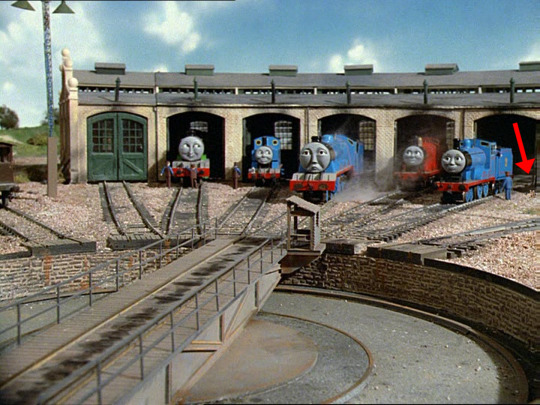
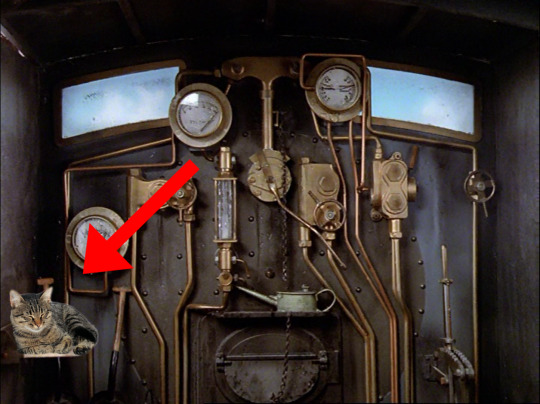
If anyone asked the engines, they would tell you Cat is a noble, but incredibly useless creature. Cat is a brown cat, nimble and swift of paw, and likes to rub against their faces sometimes, which makes Cat vibrate and rumble in a decidedly pleasant way. No matter how they argue about who should get to sleep with Cat, only Cat will choose who it will sleep with on any given night.
Every engine is convinced they are Cat's favourite engine.
There are no questions as to Cat's gender. Cat is simply a brown cat. A request for a more detailed description will get you a brown cat with black stripes.
Cat's favorite sleeping spot is either in the cab, in the cradles and crevices of sandboxes, or on the running board beneath an engine's chin. Cat makes some engines sneeze when it sleeps there. Gordon sneezes the most.
Sometimes the engines will catch Cat lying in the sun. Cat is a very lazy animal indeed and cannot be roused to do anything, but Edward proposes Cat keeps the yard clear of rats. This is only hearsay and rumor until anyone actually sees Cat catch anything.
One thing they can all agree on is Cat is unlike any other cat out there.
#ttte#thomas and friends#the railway series#i wish trains were real#ttte headcanons#shelli talks about trains again
166 notes
·
View notes
Note
Hey you're still doing the ask game thing? If so can you do Diesel 10?

The love of my life. I told my self that if I ever try getting everything from the Take Along/Take n Play ranges, he'd be at the top of the list.
1. Most of the engines believe he's given up on destroying Lady in exchange for being a general nuisance, but they couldn't be any more wrong. When he's not collecting scrap or terrorizing his fellow engines, he's on the prowl for the magic buffers.
2. Given Thomas' role in helping Lady escape, Diesel 10 kinda really hates Thomas. If given the chance, he'd scrap the little puffball on the spot, but Thomas is much too noticeable for him to ever go through with it.
3. Arry and Bert are probably the only engines on the island Diesel can wholeheartedly call his friends. Their shared disdain for steam engines have made the trio kindred spirits, much to the disdain of the others.
4. D10's a favorite among visiting children, given Pinchy and all. James often feels his boiler pressure rise dangerously when he sees children clamoring for Diesel 10.
5. The Fat Controller was very reluctant to bring Diesel 10 back to the island, but a series of heavy storms brought the need for another engine to help clean the mess up. 10 promised to be on his best behavior, but everyone quickly realized that his 'best' didn't mean much. He had a habit of 'accidentally' dropping branches and scrap on the line when Thomas was nearby, but to the tank engine's disdain.
15 notes
·
View notes
Text
Does anyone headcanon any of the TTTE characters as good singers? If so, what types of songs are they good at singing?
Personally, I think that Duck is a very good singer and guitar player. He loves to play and sing country, but he sings other genres as well. His singing voice is very deep, clear, powerful, and loud if he wants it to be.
#ttte#ttte duck#my opinion#my headcanons#ttte headcanons#thomas the tank engine#duck the great western engine#duck
28 notes
·
View notes
Text
★ ttte headcanons!! (great western fam edition)
♪ Duck;
-even IF he is the most mature out of the five of the great western crew, He is actually the youngest, He just liked being mature and making people believe he's older, He's autistic, definitely is, The reason why he waddles because he has a disability(?) Called Waddling Gait, He still has it, he just uses a cane to hide it. His parents thought of getting a service dog for him, Donald actually convinced him to play Roblox once with Toad, And Donald also told Douglas and Oliver to play with them aswell, and They all kept laughing at Duck because he kept running into the walls, running and falling down to the void, Getting flinged away by a slide, Crashing cars and running into random players in the game, And Duck was confused as hell. Used to be a barista at a coffee shop but ended up being a locomotive driver due to having a hyperfixation on them. Would deny it out of embarrassment but he secretly listens to 'SPIDER WEB' by Melanie Martinez, He's obsessed with the song too. He doesn't know if he wants to be a girl, or a boy, cause he's genderfluid.
★ Donald;
-Donald is actually the older twin, but he just happens to act so childish to the fact that people think he's younger (The reason WHY I did this is because it is more common for older twins to be more outgoing and energetic then the younger.) He genuinely can't do math unless he has a pen and paper, On top of his class at history when he was younger, Would eat anything if he knows what it is, would literally game in his freetime, and probably scam little kids. Loves pop songs. Gets drunk more. Absolutely loves Harry Potter. Does not enjoy fireworks one bit, he hates the sound of loud banging in his ear at midnight when all he wants to do is eat and get some sleep. Definitely more emotional then this brother, can laugh at anything or anyone without hesitation. His voice has a very.. impressive vocal range. Loves karaoke and singing.
★ Douglas;
-coming soon
• Oliver;
-coming soon
• Toad
-coming soon
#ttte#ttte headcanons#ttte duck#ttte donald#ttte donald and douglas#ttte douglas#ttte douglas and donald#ttte oliver#ttte toad#the great western
24 notes
·
View notes
Text
Spencer & Ryan Headcanon: Lifelong Favourite Cousins
A favourite headcanon in my AU is the close relationship Spencer shares with his younger* cousin, Ryan. Ryan is also transmasc and is fairly open about the fact that he used to be called Rhianna before starting his transition and moving to Sodor. Guided to Sodor by Spencer - and with some help from his eldest cousin, Gordon - Ryan gets to see Spencer much more frequently.
* Ryan's basis predates Spencer's (even Gordon's, I think), so he would be the eldest cousin in reality, but in my AU, Rhianna/Ryan was a late addition to the family and is therefore the youngest.
QUICK NOTE: The following is NOT SHIP ART of Spencer and Ryan. They are cousins and have a close - but appropriate - cousinly relationship. It is partly inspired by the relationship I have with my own favourite cousin.
Spencer and Rhianna: The Childhood Years

Spencer and Rhianna bonded almost from the moment they met and became inseparable as children. As they grew up, they became the most trusted people in one another's lives. This led them to confide in and come out to each other - Spencer as gay and Rhianna as trangender - before anyone else and led them to support one another when coming out to the world.
Ryan's move to Sodor was helped by Gordon putting his name forward to Sir Topham Hatt as a good fit for the new branch line. But it was Spencer, who started the move to keep 'little Rhee' safe from the threats on the mainland. With the Duke and Duchess of Boxford spending much more time on Sodor, Spencer is able to make more time to maintain his rivalry with Gordon, and now can spend more time with the person he currently loves most in the world: Ryan.
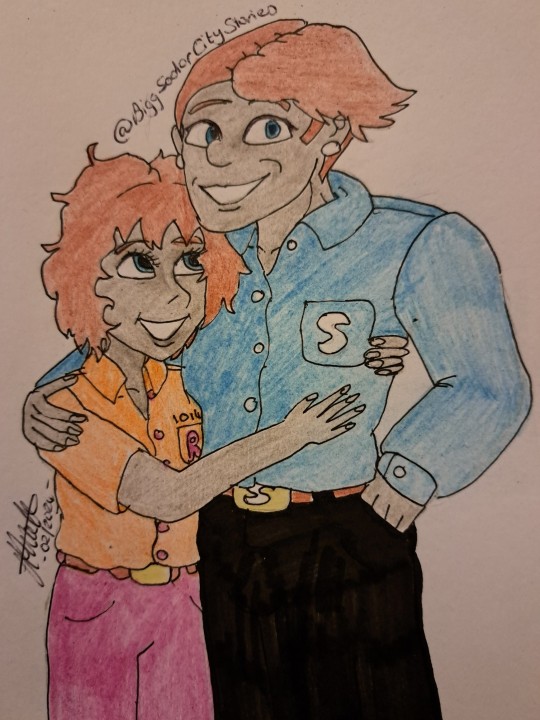
Ryan's arrival on Sodor has enabled the other engines to see a side of Spencer that they hadn't believed could exist. With Ryan, Spencer is relaxed, affectionate, and much more toned down. The two are regularly seen together, just enjoying one another's company.
#ttte#biggsodorcitystories#ttte humanized#bscs rambling#bscs art#ttte headcanons#ttte spencer#spencer the silver engine#ttte ryan#ryan the purple tank engine#gresley family#don't mess with a gresley#spencer and ryan#cousins#transmasc#transgender#ttte rhianna#their bond makes me feel so warm and fuzzy#spencer needs someone in his corner and ryan is the better fit imo
9 notes
·
View notes
Text
Locomotive Rights in Australia (Victoria): Part 1
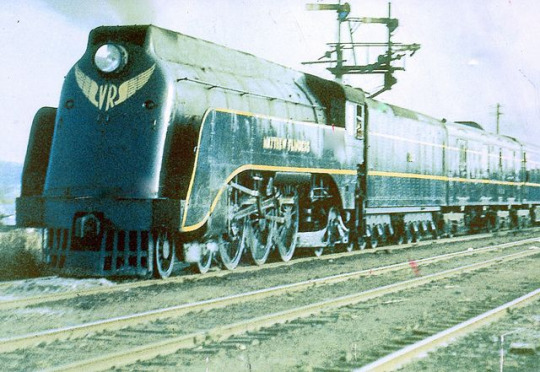
(One of the patron saints of the Locomotive Rights movement in Victoria, VR S-Class Pacific S300 Matthew Flinders, who was scrapped before he could be saved. The scrapping of the S-classes spurred the IRL steam preservation movement in Victoria)
Here I am, riffing off @joezworld's posts about Locomotive Rights as they developed around the world. Here is my personal take on what happened in Australia in regards to this issue.
(Disclaimer: Needless to say this is all fictionalised and not to be taken as a comment on any historical personage or real life locomotive. No slander is intended, this is a headcanon extrapolating Locomotive Rights in the GunzelVerse, and the TTTE/RWS AUs I write about in them, "This Is Sodor: The Iron Age" and "Red And Black Steam on Southern Metals".)
(I use the term “Lokodammerung”, literally meaning “Twilight of the Locomotives” in regards to the mass scrapping of locomotives. The Great Scrapping seems too cold, while “Dammerung” has a sad and apocalyptic timbre, which I what I wish to convey.)
If I don’t cover WAGR(Western Australia), SAR (South Australia) or QR (Queensland) , its because they are not my special interest in locomotives and I don’t know all that much about them. My apologies for the exclusion and I will try to rectify it in the future with time and research.
The situation of the railway and locomotive rights in Australia is a very strange and complex one, coded in State’s rights, custom and ideology more than anything systematic. It would be best dealt with State by State.
In spite of the celebrity of NSWGR C-38 Pacific 3801, it didn’t translate into a proper acknowledgement of non-faceless vehicles as people in of themselves until the 60’s. And even then, it was not an even process. The push actually began in the States of Victoria and New South Wales separately and converged later.
Prehistory
Upon Federation, every single State had their own specific gauge, an expression of the fervent desire for independence of the colonies before they were brought together as one nation when Australia was made into a Federation in 1901. Attempts to bring the country to a single gauge failed as each state battled with open hostility to the idea.
In the specific case of the colony of Victoria, the Broad Gauge (known widely as the “Irish’ Gague at 5’3’’) had been decided upon but as BG rolling stock and locomotives were purchased, a change of leadership brought a change of decision as to what sort of railway gauges would be used. NSW decided upon Standard Gauge of 4 ft 8 ½ inches like what was used in Britain. Victoria in a fit of pique having already paid for their goods, refused to reconsider a change of gauge.
(The Victorian terrain also suited the BG quite well, the long, broad and steep inclines requiring a more stable kind of gauge provided by the BG).
Oz is also an enormous place compared to the UK. The State of Victoria alone is the size of Great Britain and around 2700 times the size of the Island of Sodor; the states themselves cover a lot of territory compared with states in the USA. Each is its own country virtually, which makes it difficult to organise, and with the difficulties in the per-internet age toward reliable communication between engines of different states (the old break-of-gauge problem!) , it was remarkable that a resistance movement got started… and started it did.
I will now speak mainly of the State of Victoria and it’s locomotives, as this is my tendency. Without rail, Victoria could have never have been the State power that it was.
***
It was said that by the late 19th century, a Victorian human was never more than 25 kilometers from a railway line, and this was thanks to lobbying by politicans promising lines to voters… and the locomotives that requested them. As the state and the railway companies were flush with Gold Rush money, they had plenty of cash to spend to do so. The famous “Octopus Act” allowed a virtual spiderweb of iron to embrace the State, creating a near total domination of goods and passenger traffic.
Thus the locomotive was able to range quite freely within Victoria wherever they pleased, and combined with strongly built depots the sizes of which eclipsed the fleets of the NWR (the North Melbourne Locomotive Depot alone shedded 120 locomotives, compared the the total number of locos at the NWR, which was around 80 at the same time before the Norf depot was demolished) developed a certain state of educated consciousness that meshed quite nicely with the tendency towards radicalism and trade unionism.
This was aided by the amalgamation of private lines post the Railway Mania era into the governments aegis, so branchlines remained open and ready until the local version of Beeching later on turned a lot of them into tramways.
Encased within their little Broad Gauge bubble imposed by the patriotic fervor of the colonies pre-Federation, locomotives could not be as easily replaced by out-of-state loaners. The early days tended towards foreign imports that were then used as templates to be built locally… and built locally they were as a matter of state pride. A lot of VR locomotives were built at Newport Works and at Phoenix Foundary, Ballarat.
The standardization plan brought forth under the reign of Chairman of Commissioners Richard Speight in the 1880's introduced five new classes of locos (A, D, E, the so called New R-class later renamed RY, and Y) that were built locally with the aid of Kitson and Co. of Leeds, England involved in the design phase, with the view that parts could be used interchangeably across classes.
This contributed to create a certain kind of mentality within the VR locomotives of a sense of separateness and self-sufficiency which cleaved with the ever present state rivalry with their Northern neighbor, New South Wales. The overall treatment of locomotives was one of a certain kind of affection, they were tools to be sure, but more than that. It was somewhat better than the British tendency to treat the locomotives as nothing more than iron pack mules, but this was not coded into law. Status of the locomotives was by custom rather than law, which was to have consequences later on.
For a time, things were very, very good for locomotives within Victoria. An American-railways inspired Railway Commissioner , Sir Harold Clapp (the Oz equivalent to a Director, as the VR was run by a board of Commissioners spoken for by a Chairman of Commissioners), the First Thin Commissioner, had been Vice President of the Southern Pacific railways in the US and brought heavy reforms to a VR seemingly stuck in the 19th century; amongst his ideas were the integration of American design principles to VR locomotives and rolling stock, creating a distinctly rugged look to the locos with their bar-frames and pilots as well as a general increase in size, to better fit the uneven terrain of Victoria with its regular inclines of 1-50, 1-44 and even 1-30.
The amiable K-class Consolidations and the sturdy, hard working Xs and N Mikado classes were introduced in this period.
This reached the peak of design with the creation of the mighty 3 cylinder S-class Pacifics of the "Spirit of Progress" fame and then Heavy Harry at Newport, who was meant to be the first of three other H-classes built for express passenger work across Victoria. The American inspiration can be seen in his rugged bar plate frame imported from the US, the specific use of the Delaware, Lackawanna & Western Railway's name for the 4-8-4 wheel configuration, "Pocono" for him and his very strong resemblance in appearance to fellow 4-8-4s the NYC Niagara and Union Pacific 844 Living Legend. (The other two H-classes were partially built, then scrapped during the war. So Harry had two stillborn brothers, a point of lingering grief for the big engine.)
(For more info on the Delaware, Lackawanna & Western 4-8-4 "Poconos"", see here)
Classes tended to be modified rather than outright replaced, like the A and D classes (each went through at least 2-3 waves of modifications and were marked with special names designating them as such, such as A1 , A2 and Dd ) as a cost-saving measure and often lasted a long time relative to their cousins in Britain, such as the 1915 built A2 -class 4-6-0 No 986 “Pluto”, who was only withdrawn in 1963, even though the R-class Hudsons were sent from Glasgow to replace them in 1951. In their naivety, they never thought the humans could ever turn against them.
Unfortunately, Victoria with a change of Commissioners was to echo Great Britain in the bizarre way that steam was phased out and reforms brought in. Wartime Austerity and the increasing costs of running the railways were used as excuses for local "mad choppery".
Country lines deemed unprofitable were cut, maintenance was reduced and fewer and fewer services were run, which tended to alienate people from the railways.
The VR also had some people within it that like their UK equivalents, had a deep suspicion of socialism and thus sought to break the back of the trade union of drivers and firemen by literally taking away their locomotives, and replacing them with easy to drive diesels and electrics with easy to train drivers, with the excuse that they were cheaper to run, cleaner and just overall better.
(The railwaymen’s strike in 1950 was supported wholeheartedly by the locomotives of the VR, who’s maintenance had been sorely neglected in the post war austerities; the strong presence of the unions and their relationship with the bitter, fallen prince of the fleet-turned-radical Heavy Harry and the fact that an entire depot was claimed by the Communist Party at the country town of Donald gave them more impetus to phase out steam power).
Others genuinely did believe that the time of steam was passing and the future needed to be embraced. They didn’t hate the locomotives personally, it was just that they were deemed obsolete. The steam locomotives were relics, and relics didn’t deserve a place at the main table in a rapidly changing world.
So they had to go.
With no real legal protections that other locomotives had in other countries like the USA, Europe and the Soviet Union, the Victorian locomotives were vulnerable to the encroaching end. Custom and public affection by itself cannot protect against sanctioned injustice.
14th of July 1952 was the beginning of the end for steam in Victoria. The first diesels, the pug-nosed B-class had arrived in Victoria, were built by Clyde Engineering in NSW (ironically, the same home Works that birthed the mighty NSWGR C-38 Pacifics) from an American design. The complacent VR locomotives were caught by surprise by the lean and hungry diesels who were now bedecked in the same blue and gold livery as the S-class Pacifics, who’s time was running out quickly.
The Lokodammerung had reached the Broad-Gauge southern fiefdom and showed no mercy.
The fact that this left a lot of people unemployed, destroyed a lot of side industries that made up the railway (workshops, suppliers, etc) and the costs of conversion left them unmoved. If they didn’t care about humans, they sure as hell weren’t going to care about locomotives, even if they talked and thought as humans.
As if to underline the point with extreme sadism, the mighty S-class locomotives were withdrawn and scrapped with not a hint of ceremony or acknowledgement of their hard work. That the diesels were painted in their old livery served to underline the viciousness of the insult to the VR steam locomotives.
It was an ideological point clearly made even to the humans. The enginemen seemed to read it correctly and the locomotives felt it deeply, shocked that their lieges were to be the ones sacrificed as an example to the hungry god of Modernisation.
(The R-Class was often blamed in railway enthusiast circles for giving the VR an excuse to introduce diesels, but this is backwards logic placing blame on a convenient foreign imported scapegoat. They were ordered and then the decision to bring in diesels was made and excuses were built around their seeming lack of performance when they were abused and poorly treated.
As locomotives, they did not get the chance to show their virtues… as they were deliberately worked into ruin on grain haulage jobs they were never suited for by the VR, so by the time the preservation movement got their act together, only two of their number were actually in operating condition and only 7 of 70 were saved. That the R-class clan thrived in restoration clearly indicates they have had the last laugh, they outlasted the VR!)
To Be Continued...
#ttte#rws#thomasallgrownup#victorian railways#GunzelVerse#GunzelVerse Headcanons#weird train rants#ttte extended universe headcanons#ttte alternate universe headcanons#Red And Black Steam On Southern Metals#This Is Sodor: The Iron Age#ttte headcanons#ttte headcanon#thomas the tank engine#ttte au
22 notes
·
View notes
Note
Edward would definitely have Cupid (Twin Version) as one of his favourite songs. Bonus if it’s James singing the song to his beloved.
I can see that!
Humanized, I think this would be one of the many songs James and Edward would play in the living room while they dance together. Edward loves dancing, swaying to and fro in the arms of his beloved. Nothing beats it. 💙
As engines, I imagine Edward's driver would bring a record player or something like that into the shed to play for him. The sound reverberates in the shed so everyone can hear it, but they all know it's mostly for Edward. Edward and James, more often than not, rest in the berths closest to each other. And when the music plays, they bob along with it together, humming along to the tune, happy to be in each other's presence.
#ttte 2x5#2x5#jameward#ttte edward#ttte james#ttte#thomas and friends#ttte headcanons#randys headcanons#ask answered#redengineposts
15 notes
·
View notes
Text
finally came up with a base idea for lady
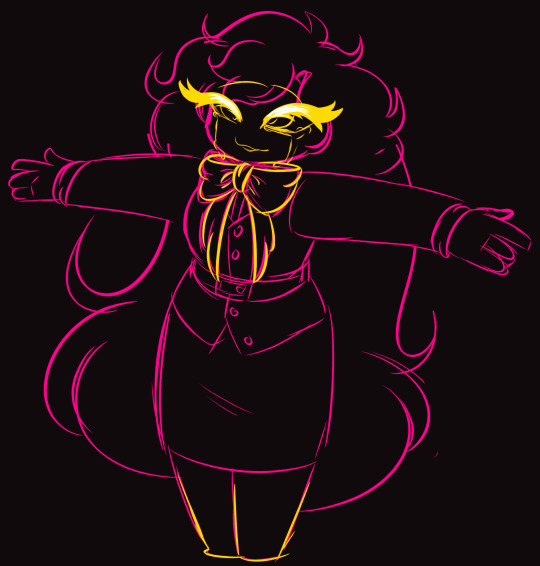
gold dust mfs have those bigass eyelashes
#ttte#thomas and friends#thomas the tank engine#ttte au#ttte gone dutch#ttte headcanons#ttte humanized#ttte human au#ttte ask blog#ttte lady#ttte humans#ttte human#ttte humanization#ttte gijinka#ttte gone dutch au#ttte aus
62 notes
·
View notes
Note
hey hey! just wondering if you had any other cool ship headcanons (or qpr headcanons oooo so fun (i myself am aroace so i find it fascinating) that you wanted to talk about (poly/qpr 156 enjoyer anon here! I loved your extra talking about it, twas glorious!) I just like hearing your thoughts!! They are most intriguing to me! Have a great day!
Hello!!! God, pleased you like my silly little rambles, especially about The Worst Polycule Ever (Affectionate).
When it comes to shipping i usually see Thomas as mega aro so i don't usually ship him. But him and James is too funny (and theu have the long standing dynamic godbless).
I think that Thomas/Bertie is aro4aro. They are a qpr and their love language is competition. People assume their constant challenges to each other is like, >:/ flavoured but in reality it's 🥰 flavoured.
I had once said a couple years ago and then rediscovered recently an ask about Duck i had answered where I had alluded to Duck/Percy qpr in the tags and i think i'm so right for that. They are hardworking4hardworking, green4green, takenoshit4takenoshit. Percy saw him be brought into the yard and went thank god a normal person and Duck saw him and went you're the only bitch here I respect. Guess I'll imprint on you.
Percy/James is peak qpr as well. I can't articulate my thoughts on it much better than hou've already seen but like they just hang out man
And like. I've really tried to get into Thomas/Percy as romantic but Thomas is too aro in my brain. Thomas may have been Percy's first crush but it was never reciprocated ans then he discovered himself n his identity more. They're qpps to me. Arospec4arospec. Percy started talking about how weird Romance was and Thomas went ugh yeah fr also hey you know there's a word for that and Percy went ☆.☆ Oh. (Tm)
So if Thomas/James does happen (and that Is romantic to me) thomas Would tell James to ask Percy first lmao. And theyre messy and codependent like that.
#ttte#dj got asked#idk if i should character tag#ttte shipping#ttte headcanons#thank uou for asking this was fun to actually condense my thoughts#and helped pass the time before i have to go to the doctor
6 notes
·
View notes
Text
A sudden headcanon popped in my head after seeing a video of LNER 60007 Sir Nigel Gresley with class 47 Lady Diana Spencer. Almost all mainline steam excursions have helper diesels at the rear. Emotional support diesels. Almost all steam engines that made it to the end of steam and BR were horribly neglected. Many were run until they broke down then dragged off to scrap. Those who survived in preservation probably have a phobia of failing their trains, because for them that meant scrap. More than one excursion ended in tears after the steam engine failed. The solution? Emotional Support Diesels. (Much Like Gold in @tornadoyoungiron 's fics). Engines that can take the train if the steam engine suffers a malfunction, having someone the engine already knows take the train rather than a random engine, makes it far less likely for the steam engine to have a panic attack. Support diesels are specifically chosen for their temperament and personality. What do the diesels get out of this? Well it's a mark of prestige. You are trusted by both management and the preservation groups to be given the job. You are seen by railfans alongside legendary locomotives as you travel around the country on special trains. And if you do it well? It's also an almost ironclad guarantee of preservation. When the first generation of support diesels faced withdrawal, it was quickly realized that the steam engines were in no way willing to let support diesels be cut up, even if the diesel in question had not been their specific diesel. After an incident where three Great Western castles stormed a scrapyard to save the diesel formerly attached to Thompson B1 "Mayflower", it became policy to arrange for support diesels to be slated for preservation prior to withdrawl.
81 notes
·
View notes
Text
TTTE Sick Headcanons
Thomas: Buries himself under a big mountain of blankets and turns into a crab
Edward: goes to work anyways, but then everyone acts like he’s dying of tuberculosis whenever he coughs and keeps the AED nearby in case he keels over even though it’s just a minor head cold.
Henry: Just another Tuesday, goes to work anyways
Gordon: sulks at home under a heavy quilt and is mad at the entire world because he can’t breathe through his nose
James: turns into a dramatic snotty mess, acts like he’s dying.
Percy: is high on NyQuil
Toby: tries to quarantine himself so Henrietta doesn’t get sick. Of course Henrietta fusses over him even though he told her not to worry about him.
Duck: goes to work anyways because according to him, it’s nothing compared to being bedridden with Polio. Gets sent home halfway through the day.
Donald: tries to tough it out.
Douglas: gets sick along with Donald because when Donald gets sick, then he gets sick.
Oliver: goes to work and tries to tough it out only to be dragged back to bed by Toad against his will.
Emily: sleeps the entire time and uses up all the tissues.
Diesel: lies on the bathroom floor in agony in the most dramatic fashion
Paxton: doesn’t get sick often, but tries to take care of Diesel, only to use the wrong thermometer and get cussed out.
Salty: for some reason never gets sick, not even a head cold.
Skarloey: stays in bed and eats nothing but soup and tea
Duncan: hates the entire world and wants to fling everything and everyone into the harbor except for Rusty who’s trying to help him feel better.
Daisy: is an absolute snotty mess and bosses others around to do her work while she stays at home and suffers.
Bill: gives his flu to Ben
Ben:
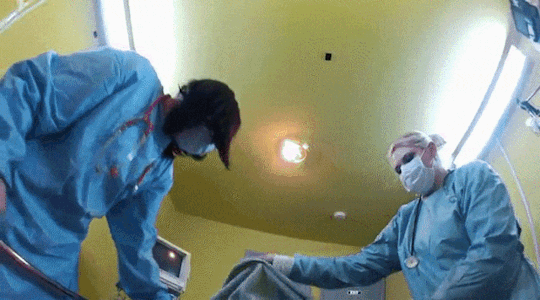
36 notes
·
View notes